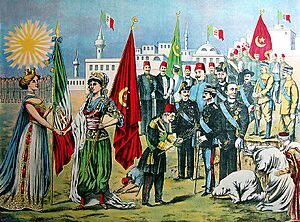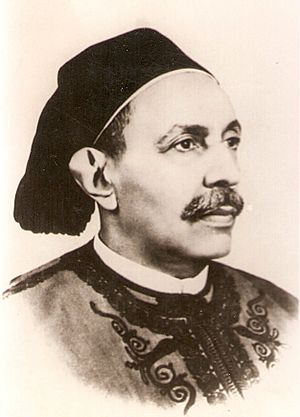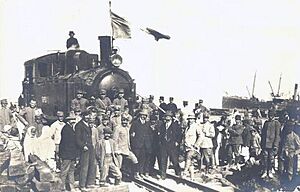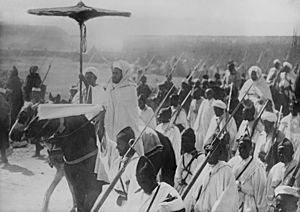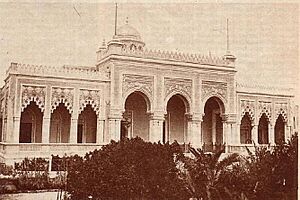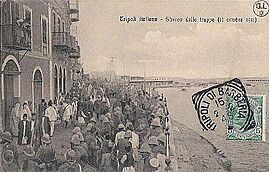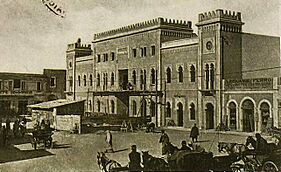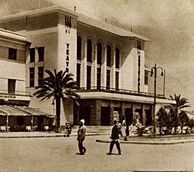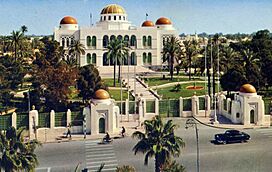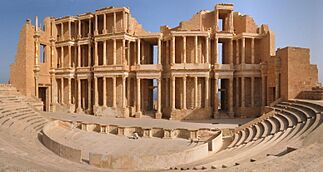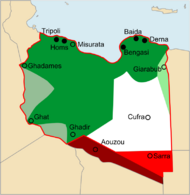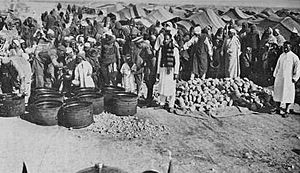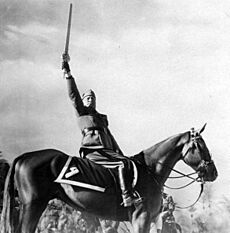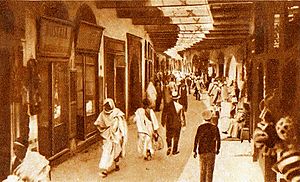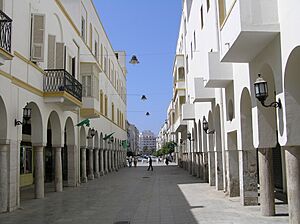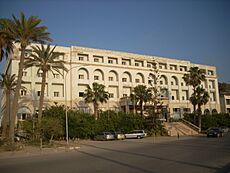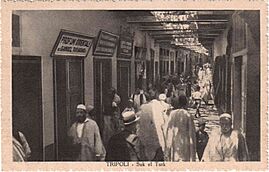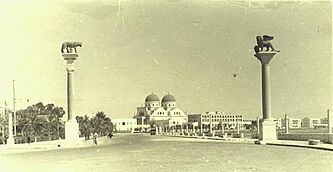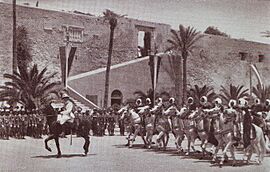Italian colonization of Libya facts for kids
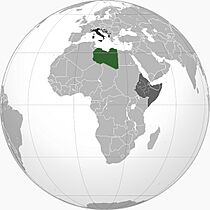
|
|
| Italian Tripolitania & Cyrenaica | 1911–1934 |
|---|---|
| Italian Libya | 1934–1943 |
The Italian colonization of Libya was a period when Italy controlled the country of Libya. This happened from 1911 to 1943. Before Italy took over, Libya was part of the Ottoman Empire.
Italy occupied Libya in 1911 after a war called the Italo-Turkish War. This led to the creation of two separate Italian colonies: Italian Tripolitania and Italian Cyrenaica. In 1934, these two colonies were joined together and officially named Italian Libya.
Later, in 1937, Libya was divided into four provinces. By 1939, the areas along the coast became an official part of Italy, known as the Fourth Shore. Italian rule ended in 1943 when Allied forces took control of Libya during World War II. However, Italy officially gave up its claims to Libya's land in 1947, after the Paris Peace Treaty.
Contents
Italian Rule in Tripolitania and Cyrenaica (1911–1934)
How Italy Took Control
On October 3, 1911, Italy attacked Tripoli, claiming they were freeing the Ottoman areas from Istanbul's rule. Even though many Arabs fought back, the Ottoman sultan gave Libya to the Italians. This happened when they signed the 1912 Treaty of Lausanne.
The Italians used local cavalry troops called the Savari. These units were made up of Arab-Berber people from Libya. The Savari, along with the Spahi (mounted police), were part of the Royal Corps of Libyan Colonial Troops. By 1914, Italy mostly controlled Tripoli. However, in Cyrenaica and the Fezzan regions, there were strong rebellions led by the nomadic Senussi people.
Sheikh Sidi Idris al-Mahdi as-Senussi (who later became King Idris I of Libya) led the Libyan resistance. He fought against the Italian army after they invaded Cyrenaica in 1913. When the Senussi leader, Ahmed Sharif as-Senussi, stepped down, Idris, his cousin, took his place. Ahmed had been pressured by the Ottoman Empire to attack British forces in nearby Egypt. Idris stopped these attacks when he took power.
Instead, Idris made a quiet agreement with the British. This agreement lasted for 50 years and gave his group a special diplomatic status. Using the British as helpers, Idris started talks with the Italians in July 1916. These talks led to two agreements in 1916 and 1917. The 1917 agreement left most of inland Cyrenaica under the control of the Senussi.
Relations between the Senussi and the new Tripolitanian Republic were not good. The Senussi tried to expand their power into eastern Tripolitania, but they were forced to retreat back to Cyrenaica after a battle.
At the end of World War I, the Ottoman Empire signed a peace agreement. In this agreement, they gave up their claims to Libya to Italy. However, Italy had many problems at home and was not ready to restart its military actions in Libya. So, Italy created laws called the Legge Fondamentale for both Tripolitania and Cyrenaica in 1919.
These laws allowed Libyans to have joint Libyan-Italian citizenship. Each province also got its own parliament and governing council. The Senussi were mostly happy with this, and Idris even visited Rome to celebrate the new agreement.
In October 1920, Italy and Cyrenaica had more talks. They signed the Accord of al-Rajma. This agreement gave Idris the title of Emir of Cyrenaica. It also allowed him to manage the oases around Kufra, Jalu, Jaghbub, Awjila, and Ajdabiya on his own. As part of the agreement, the Italian government gave him a monthly payment. They also agreed to be responsible for policing and managing areas under Senussi control. The agreement also said Idris had to break up the Cyrenaican military units, but he did not do this. By the end of 1921, relations between the Senussi and the Italian government had worsened again.
After the death of Tripolitanian leader Ramadan Asswehly in August 1920, the Republic fell into civil war. Many tribal leaders saw that this fighting was making it harder for the region to become fully independent from Italy. In November 1920, they met to stop the violence. In January 1922, they asked Idris to extend his Senussi rule into Tripolitania to bring stability. They formally asked him on July 28, 1922.
Idris's advisors were divided on whether he should accept. Doing so would go against the al-Rajma Agreement and hurt relations with the Italian government. Italy did not want Cyrenaica and Tripolitania to unite. However, in November 1922, Idris agreed. After this, Idris worried that Italy, now led by the new Fascist leader Benito Mussolini, would attack the Senussi. So, he went into exile in Egypt in December 1922.
-
An Italian Carabiniere and an Arabic Zaptié patrolling in Tripoli, 1914
-
Restaurant and goods train in Derna (stamped on 29 December 1916)
The Second Italo-Senussi War
When Benito Mussolini became the leader of Italy, the fighting in Libya became much more intense. The Libyan people strongly resisted Italy's efforts to control the area. Because of this, Italy's colonization of the Ottoman provinces of Tripolitania and Cyrenaica was not successful at first. It wasn't until the early 1930s that Italy gained full control. This conflict, known as the Second Italo-Senussi War, caused the deaths of about 56,000 Libyans.
Italy had to change its colonial government several times because of the armed resistance from Arabs, especially in Cyrenaica. From 1919 to 1929, the Italian government kept the two traditional provinces with separate colonial administrations. They set up local assemblies with limited power, but this system was removed in 1927. In 1929, Tripoli and Cyrenaica were joined into one colonial province.
From 1931 to 1932, Italian forces led by General Badoglio carried out a harsh campaign to control the area. Badoglio's replacement, General Rodolfo Graziani, took over after Mussolini agreed to let him crush the Libyan resistance without following Italian or international law. Graziani then made the oppression even worse.
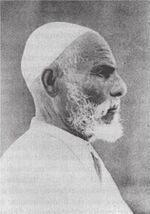
Some Libyans continued to fight back, especially in Cyrenaica. From the very beginning of Italian colonization, Omar Mukhtar, a Senussi sheikh, organized and led the Libyan resistance movement for nearly twenty years. His bravery continued to inspire others even after he was captured and executed on September 16, 1931. Today, his face is on the Libyan ten dinar note to honor his patriotism.
After a disputed truce, Italy's policy in Libya turned into a full-scale war in 1932. A barbed wire fence was built from the Mediterranean Sea to the oasis of Jaghbub. This fence was meant to cut off supplies and communication lines for the resistance fighters. Soon after, the Italian colonial government began to remove people from the Jebel Akhdar area. This was done to prevent the local population from supporting the resistance.
The forced migration of over 100,000 people ended in large camps in Suluq and El Agheila. Thousands of people died in these camps due to terrible conditions. It is thought that at least 80,000 Libyans died from fighting, starvation, or disease. This was up to one-third of the population of Cyrenaica.
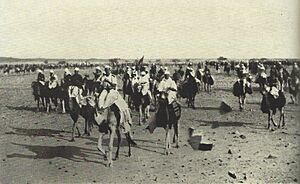
Both sides committed serious acts during the war. Italian authorities forcibly removed 100,000 local Cyrenaicans, almost half the population, from their homes. These lands were planned to be given to Italian settlers. Historian Angelo Del Boca estimated that between 40,000 and 70,000 Libyans died due to forced removals, starvation, disease in the camps, and executions. The Italian occupation also greatly reduced the number of farm animals. For example, the number of sheep fell from 810,000 in 1926 to 98,000 in 1933.
From 1930 to 1931, 12,000 Cyrenaicans died. All the nomadic people of northern Cyrenaica were forcibly moved to large camps in the lowlands of Cyrenaica. The Fascist government's propaganda claimed these camps were modern and clean. However, in reality, the camps had very poor sanitation. They held an average of about 20,000 people, along with their camels and other animals, all crowded into a small area. The camps had very basic medical services. For example, the Soluch and Sisi Ahmed el Magrun camps, with about 33,000 people, had only one doctor between them. Diseases like Typhus spread quickly because people were weak from forced labor and not enough food. By the time the camps closed in September 1933, 40,000 of the 100,000 people held in them had died.
Italian Libya (1934–1943)
By 1934, the Libyan resistance was largely defeated. The new Italian governor, Italo Balbo, created the political area called Italian Libya in the summer of that year. The old name "Libya" was brought back as the official name for the united colony. Then, in 1937, the colony was divided into four provinces: Tripoli, Misrata, Benghazi, and Derna. The Fezzan area was called Territorio Sahara Libico and was managed by the military.
In March 1937, Mussolini visited Libya. He opened a new military highway that ran across the entire colony, called the Via Balbia. For propaganda reasons, he declared himself "Protector of Islam" and was given a symbolic sword. Mussolini's public support for the Arab nationalist movement fit his larger goals of challenging Britain and France.
He also wanted to fully colonize Libya. He brought 30,000 more Italian settlers, increasing their numbers to over 100,000. These settlers were mainly sent to Sahel al-Jefara in Tripolitania and the Jebel Akhdar in Cyrenaica. They were given land from which the local people had been partly removed during the colonial war in the 1920s. By the 1939 census, Italians made up 108,419 people (12.37% of the total population) in Libya. They mostly lived on the coast around Tripoli (37% of the city's population) and Benghazi (31%). The 22,000 Libyan Jews were allowed to live in the society of the "Fourth Shore." However, after summer 1941, with the arrival of the German Afrika Korps, they began to be moved to internment camps under Nazi SS control.
On January 9, 1939, the coastal regions of the colony became part of Italy itself. Italy then considered them an official part of its country. By 1939, the Italians had built 400 km of new railroads and 4,000 km of new roads. During World War II, a new road, the Via della Vittoria, and a new Tripoli-Benghazi railway were still being built. On September 13, 1940, Mussolini's highway was used by Italian forces in Libya to invade Egypt.
In 1939, laws were passed that allowed Muslims to join the National Fascist Party. They could also join the Muslim Association of the Lictor. These changes allowed for the creation of Libyan military units within the Italian army, with 30,000 local Muslim soldiers. Two divisions of Libyan colonial troops were formed (1st Libyan Division, 2nd Libyan Division). In the summer of 1940, both divisions took part in the Italian attack against the British army in Egypt. A battalion of Libyan paratroopers was even created shortly before World War II. This was the first force of its kind in all of Africa. Other Libyan troops had been fighting for Italy since the 1920s, including the Savari (cavalry regiments) and the Spahi (mounted police).
Mussolini wanted to make the Arabs of Libya (whom he called "Muslim Italians") part of Italian society. So, in 1939, ten new villages were built for Arabs and Berbers:
- "El Fager" (meaning Dawn)
- "Nahima" (meaning Delicious)
- "Azizia" (meaning Perfumed)
- "Nahiba" (meaning Risen)
- "Mansura" (meaning Victorious)
- "Chadra" (meaning Green)
- "Zahara" (meaning Blossomed)
- "Gedina" (meaning New)
- "Mamhura" (meaning Flourished)
- "El Beida" (meaning White)
All these new villages had their own mosque, school, social center (with sports fields and a cinema), and a small hospital. This was supposedly a reward for the good performance of the Libyan colonial troops in the military. In 1936, Savaris and other Libyan units took part in the Italian invasion of Ethiopia. They received a "Gold Medal of Honour" for their excellent performance in battle.
-
The Catholic Cathedral was connected to the "Via Vittoria", which had two columns featuring the Lion of Venice and the Capitoline Wolf
End of Italian Rule
From 1943 to 1951, Libya was under Allied occupation. The British military managed the former Italian provinces of Tripolitania and Cyrenaica. The French managed the province of Fezzan.
Under the 1947 peace treaty with the Allies, Italy gave up all its claims to Libya. Italy had hoped to keep the colony of Tripolitania. France had wanted to keep the Fezzan region. Libya remained united as it went through the process of becoming independent from European colonial rule in the mid-20th century.
Omar al-Mukhtar's last years were shown in the movie Lion of the Desert (1981). It starred Anthony Quinn, Oliver Reed, and Irene Papas. The Italian authorities banned the film in 1982. They said it was "damaging to the honor of the army."
In July 1998, the Italian government formally apologized to Libya. In August 2008, the two countries signed a friendship treaty. Italy agreed to provide US$5 billion in goods and services, including building part of the Cairo-Tunis highway in Libya. This was meant to end any remaining hard feelings. In return, Libya would work to stop illegal immigration from its shores and increase investments in Italian companies.
Italy approved the treaty on February 6, 2009. Libya approved it on March 2, during a visit to Tripoli by Silvio Berlusconi. He recognized the historical harm and oppression caused by Italy to the Libyan people during colonial rule.
This cooperation ended in February 2011 because of the 2011 Libyan Civil War. This war overthrew Gaddafi's government. On September 26, 2011, the Italian energy company Eni announced it had restarted oil production in Libya. This was the first time since the civil war began. Eni's quick return to Libyan oilfields showed the good relationship between Rome and Tripoli.
The Italian embassy in Tripoli is one of the few Western embassies still open in Libya during the Post-civil war violence in Libya. This is because Italy is Libya's most important trading partner.
See also
- List of colonial heads of Libya
- Italian Libya
- Fourth Shore
- Italo Balbo
- Italy–Libya relations
- Savari
- Spahi
- Ascari del Cielo
- Italian Libyan Colonial Division
- Tripoli Grand Prix
- Italian Empire
- Via Balbia
- Via della Vittoria
- Italian Libya Railways
- Aouzou Strip


